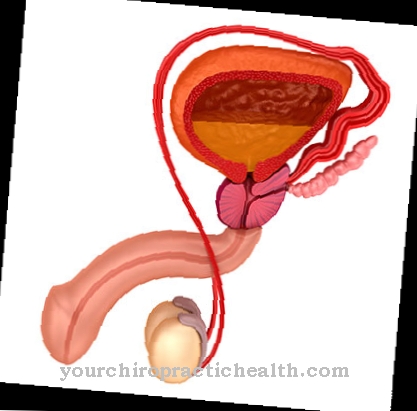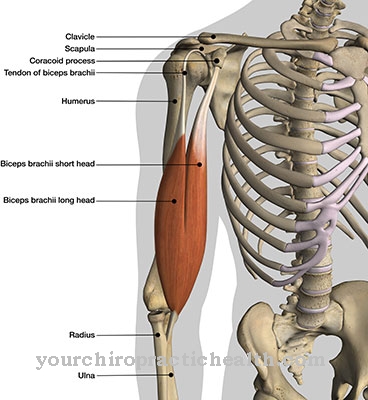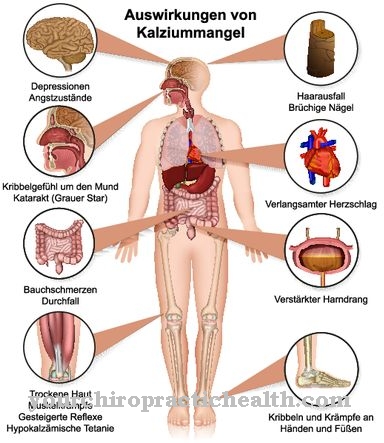Under a Osteoid osteoma a benign tumor change in the skeleton is understood. The benign bone tumor seldom causes symptoms.
What is an osteoid osteoma?

© Olga - stock.adobe.com
Osteoid osteoma is the name of a tumor whose origin lies in the osteoblasts (special bone cells). The bone tumor has a diameter of up to two centimeters. It is particularly common on long bones. This primarily includes the thighbones (femur) and the shinbone (tibia).
In terms of the frequency of benign bone changes, the osteoid osteoma ranks third behind the osteoma and non-ossifying fibroma. The bone tumor appears mainly in adolescence. The upper part of the thighbone is particularly affected. But the shins and spine are also often affected by the changes.
The proportion of bone tumors in osteoid osteomas is around 14 percent. In most cases, it shows up in teenage males between the ages of 10 and 20 years. Sometimes the tumor occurs before the age of 10. From the age of 30, it is very rare.
causes
The osteoid osteoma has its origin in the hard outer cortex of the bone tissue. So far it has not been possible to find out what causes the benign bone tumor. An osteoma is inherited in some cases. External physical and chemical influences are in the discussion about the cause of the tumor. Injuries and nuclear radiation are also considered possible triggering factors.
Benign bone tumors often show up when the bones grow too quickly. Growth hormones are also considered a possible risk factor. In bone tumors, medicine differentiates between osteoid osteomas, osteomas and osteoblastomas, which originate in the bone cells, osteochondromas, chondroblastomas and chondromas which originate in the cartilage tissue, osteoclastomas and bone fibromas which originate in the connective tissue, and bone hemangiomas which originate in the vascular tissue.
Symptoms, ailments & signs
In many cases, an osteoid osteoma does not cause any symptoms. However, some patients may experience pain, which occurs mainly during the night. They usually set in suddenly and show up on the knee, hip or back. However, the symptoms do not clearly indicate an osteoid osteoma.
They occur independently of movement and come from the depths. The pain usually improves after taking acetylsalicylic acid (ASA). Occasionally, the benign tumor can even be felt, which is noticeable as a local swelling.
Diagnosis & course of disease
If the pain caused by the osteoid osteoma leads the young patient to a doctor, the doctor first looks at the medical history (anamnesis). The doctor asks when, how often and where the pain has been occurring. A physical examination will be carried out after the interview. Occasionally, the doctor can feel the tumor.
Imaging methods are used to obtain further information. This mainly includes taking x-rays. A swelling of the cortex (bone cortex) can usually be seen in the pictures. Furthermore, there is a connective tissue compression, which has a size of a few centimeters. In the center of the condensation, a round, brightening focus can be seen, which is called the nidus.
Computed tomography (CT) can be used to determine the extent of the tumor. Another diagnostic method is the bone scintigram. In this procedure, radioactive substances are administered into the bone tissue. This enables the doctor to determine the increased absorption of technetium. A bone biopsy (removal of tissue) is carried out to confirm the diagnosis.
The sample taken is then examined in a laboratory under a microscope. Connective tissue that is well supplied with blood and is surrounded by sclerotic bone is an indication of an osteoid osteoma. Blood tests are more suitable for excluding other diseases because the osteoid osteoma does not cause any changes in the blood.
An osteoid osteoma takes a positive course. This means that metastases (daughter tumors) do not develop. Malignant degeneration is also excluded. If the benign bone tumor is removed by surgery, it usually heals.
Complications
The osteoid osteoma itself does not usually cause complications. It is a benign bone tumor that has no tendency to degenerate. However, the disease is noticeable with pain, which usually occurs at night. Since the pain often becomes chronic, it is essential to treat it.
If left untreated, however, they can trigger various complications such as stunted growth, arthritis or scoliosis. The pain causes bad posture through constant avoidance behavior. These consequential damages can lead to restricted mobility and additional chronic pain. Psychological problems such as depression can of course also occur as further consequences if the patient feels that he is no longer able to participate in daily life.
This is particularly serious for those affected because the disease usually occurs in a particularly sensitive and stormy phase of growth between the ages of 11 and 20 years. In order to avoid these serious effects, if an osteoid osteoma is present, an attempt is first made to alleviate the pain symptoms with medication by administering ASA. In some cases, however, that doesn't help.
Then surgical removal of the tumor is called for. Ablation of the nidus with the help of toxic substances or radiofrequency therapy is also possible. The method of curettage, which used to be common in the past, is no longer carried out because it often resulted in recurrences due to incomplete removal.
When should you go to the doctor?
Bone pain, restricted mobility, and sensory disorders in the arms or legs suggest an osteoid osteoma. Specialist help is needed if the warning signs persist for a long time or get stronger quickly. A doctor should also be consulted if other symptoms occur. Osteoid osteoma is a serious condition that needs to be diagnosed and treated immediately. Otherwise the tumors can spread and spread to other organs outside the bones or even affect other bones. Anyone who notices increasing pain that cannot be traced back to a specific cause should speak to the doctor immediately.
This is particularly necessary if cancer has already occurred in the past. Then the sick person has to speak to the responsible doctor. The same applies to genetic predispositions or the presence of any risk factors, for example work in a nuclear power plant or contact with other cancer-causing substances. Affected people should speak to their family doctor, an oncologist or an orthopedic surgeon. Depending on the severity of the disease, the tumor must then be removed surgically or using radiation or chemotherapy. Therapy and follow-up care are always carried out under strict medical supervision.
Treatment & Therapy
Treatment of the osteoid osteoma is not always necessary if there are no symptoms and the bone is stable. In addition, the diagnosis must be secured. The aim of therapy is to remove the pain and stabilize the bone again.
The therapy of an osteoid osteoma takes place surgically. The bone tumor has to be removed completely in order to be free of symptoms. Otherwise there is a risk that it will form again later. The procedure for a surgical procedure depends on the part of the body where the tumor is located.
If it is located in an area where there is little physical strain, the surgeon will operate it in blocks from the affected bone area, while at the same time removing the edge. If, on the other hand, the tumor is in an unfavorable position and there is therefore a risk of bone fracture, the cortex is first removed until the nidus can be seen in the surgical area.
It is removed with a surgical curette. However, this method has the disadvantage that the tumor may not be completely removed. This is especially true in difficult to access operating areas. One advantage of the method, on the other hand, is the stability of the bone tissue and the lower risk of bone fracture.
You can find your medication here
➔ Medicines for joint painOutlook & forecast
Although the osteoid osteoma is a form of bone cancer, the prognosis is positive. On the one hand, an osteoblastic tumor is very small. Sometimes it's just the size of a pinhead, sometimes it's the size of a cherry pit. Second, the osteoid osteoma is a benign new bone formation. Metastases therefore do not occur.
Nevertheless, the osteoid osteoma is one of the primary tumor types. Young people below the age of thirty are particularly affected. As the third most common bone tumors, osteoid osteomas primarily affect male patients. The prognosis depends on the extent and location of the bone tumor. However, osteoid osteomas are very unlikely to become malignant. After the diagnosis, people often wait to see how the tumor develops. The reason for this is that 30 percent of osteoid osteomas regress spontaneously.
If this is not the case, surgical removal of the tiny tumor may have to be considered after unsuccessful pain therapy. This is useful if the tumor causes excessive pain. These tend to occur at night. They can become chronic. To prevent chronification and the resulting complications, the removal of the osteoid osteoma is recommended. This can prevent pain-related postures, growth problems and other consequences of tumor formation.
The previously performed curettage of the tumor often led to tumor recurrences. It is no longer practiced today.
prevention
It is not possible to prevent an osteoid osteoma. The responsible causes are still unknown.
Aftercare
Follow-up care is an essential part of cancer therapy. Sufferers are invited to continuous follow-up checks to prevent the symptoms of a new tumor. An osteoid osteoma is a benign tumor. This also requires follow-up care, not only after an operation, but also if you do not have an operation.
The latter procedure is common in the absence of complaints. The observation serves as a precautionary measure to avoid complications. The doctor and patient agree on the location and rhythm of the follow-up care. Most examinations take place in a clinic. Half-yearly appointments are usually sufficient for an inspection.
Quarterly presentations are useful immediately after therapy. Rehabilitation measures can be useful after a surgical procedure. Therapists accompany you on your way into everyday professional and private life. A follow-up examination consists of a detailed discussion in which possible complaints are asked.
Imaging methods such as x-rays and a CT allow clear conclusions to be drawn as to whether the tumor has developed further or has emerged again. If movement restrictions have arisen due to an osteoid osteoma, physiotherapy can help. Many patients receive pain medication from time to time after the procedure, the effect of which is gradually reduced.
You can do that yourself
Despite the good prognosis and the fact that these tumors are benign and do not cause any symptoms of their own, patients can suffer from pain. For example, if the tumor sits on a joint or presses on a nerve, movement can be impaired. For this reason and other medical considerations, the treating physicians may then recommend that the osteoid osteoma be surgically removed.
The physiotherapy and / or occupational therapy sessions prescribed after an operation must be adhered to, as they are intended to prevent the operated areas from sticking and thus further restricted mobility. The exercises learned there should also be continued after the therapy. In any case, the patient should be prepared for several years of medical follow-up, as the osteoid osteoma can recur.
Patients with an osteoid osteoma that have not been removed must fear that the bone in this area will break faster. Therefore, you should carefully protect yourself from accidents. Abrupt loads and compression should also be avoided. Less accident-prone sports such as hiking, jogging or cycling are recommended instead of football or other team sports.
Since the disease most often shows between the ages of eleven and eighteen years of age, care must be taken to ensure that no bones or joints are deformed during the growth phase due to the osteoid osteoma. In case of doubt, close medical checks are indicated.






.jpg)

















.jpg)



